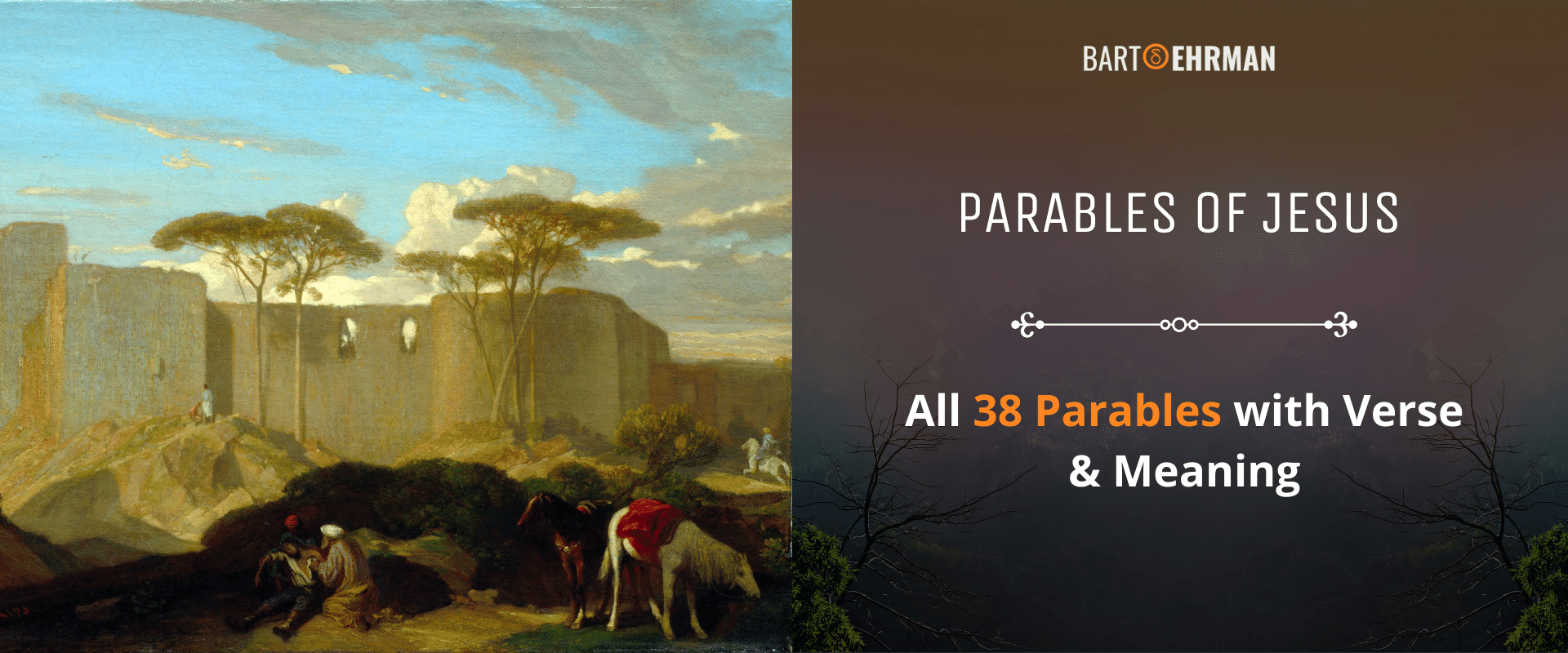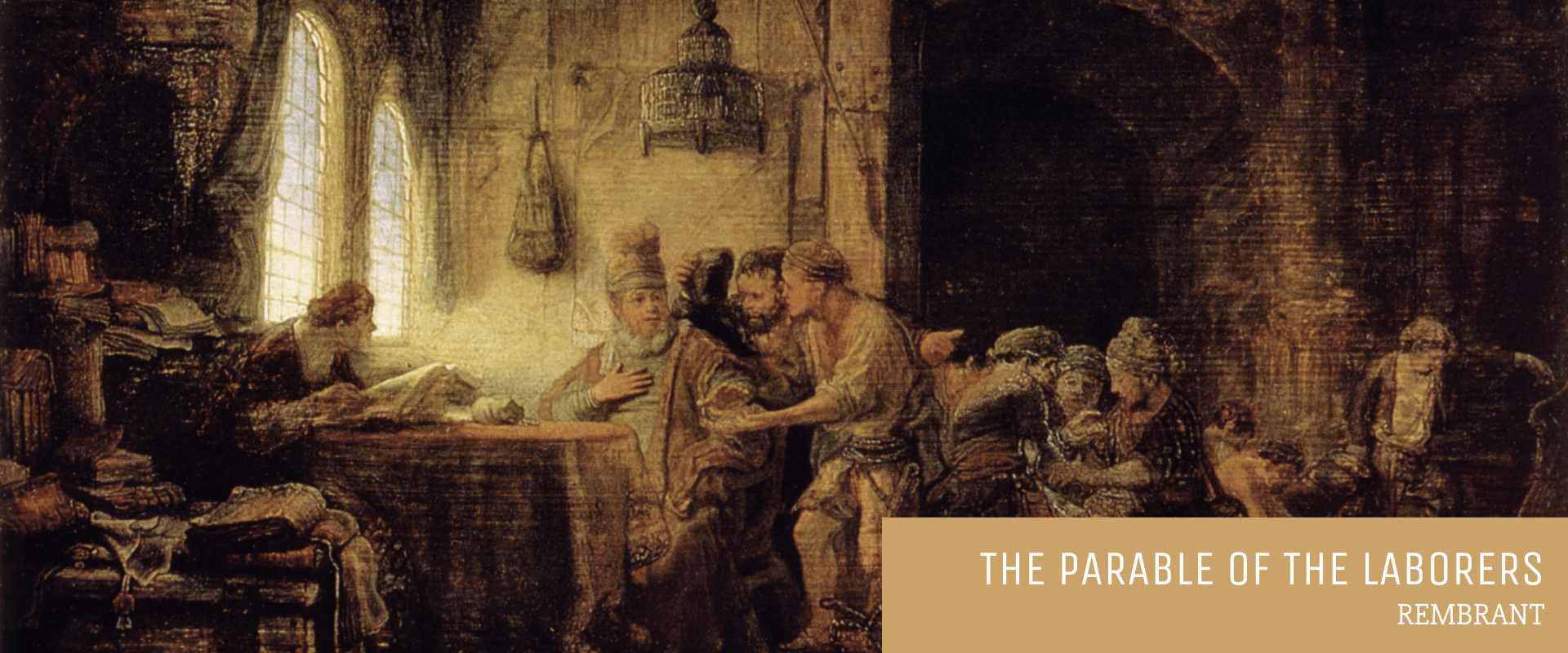Parables of Jesus (All 38 Parables with Verse & Meaning)

Written by Marko Marina, Ph.D.
Author | Historian | BE Contributor
Verified! See our guidelines
Verified! See our editorial guidelines
Date written: May 14th, 2024
Disclaimer: The views and opinions expressed in this article belong to the author and do not necessarily match my own. - Dr. Bart D. Ehrman
Teaching is a noble profession," wrote Elizabeth A. Seton, "that shapes the character, intellect, and souls of the future generations." As a teacher myself, I understand deeply the profound impact that teaching can have.
Throughout history, educators have employed many methods to impart wisdom and attract followers. Among these methods, the use of parables stands out as a particularly effective and engaging approach.
Skip Intro
By their very nature, parables are simple but effective teaching aids. They wrap deep truths in everyday stories and make complex ideas accessible and comprehensible for all listeners. This teaching method isn’t only timeless but also transcends cultural and linguistic barriers so that the teachings resonate across different societies and eras.
The parables of Jesus, as recounted in the New Testament, are some of the quintessential examples of this teaching method. These parables not only shaped the spiritual landscape of their time but continue to offer valuable lessons today.
This article aims to explore all 38 parables attributed to Jesus, providing a clear and concise overview of each. Designed for a lay audience, this guide will present these parables in a structured format, listing each parable along with its biblical references and a brief interpretation of its meaning.
By doing so, we hope to offer readers both a scholarly and approachable resource that enriches their understanding of these ancient narratives.

Are You Missing Half the Story in the Parables?
Discover how Jesus’ most familiar parables take on surprising new meaning when read in their original Jewish context.
4 lectures plus exclusive bonus content
Whether you are a student of theology, a casual reader seeking insight, or simply curious about the teachings of one of history’s most influential figures, this comprehensive guide to the parables of Jesus will serve as a valuable resource.
Jesus' earliest parables are found in the Gospel of Mark. If you're intrigued by the mysteries surrounding this foundational text, consider Dr. Bart D. Ehrman's course, "Jesus the Secret Messiah - Revealing the Mysteries of the Gospel of Mark."
Delve into the historical context of Mark's Gospel, explore whether Mark had firsthand knowledge of Jesus' life, and uncover the scholarly truths behind these ancient writings. Join now to discover more!

The Parables of Jesus: Definition and Historical Context
A parable is typically defined as a "short fictitious story that illustrates a moral attitude or a religious principle." This form of storytelling, particularly in the teachings of Jesus, has been a profound method for conveying spiritual truths through everyday, mundane scenarios.
Bart Ehrman underscores that Jesus "attracted crowds by his inspired and challenging teaching, especially when he told parables, brief stories of everyday, mundane affairs that he endows with deep spiritual significance.
How many parables of Jesus are there? While that depends on the way one classifies the parable, it’s safe to say that there are around 38 parables of Jesus in the New Testament.
It’s important to note, however, that Jesus didn’t originate this method of teaching. But he did make them his main way of spreading his teachings. The parables of Jesus represent an adaptation and expansion of a form of wisdom that already existed within Judaism.
The concept of wisdom through storytelling was already present in early Jewish literature, such as The Book of Sirach from the beginning of the second century B.C.E. This book, a collection from the Jewish upper class, predominantly features wisdom teachings through pointed sentences, riddles, and reflections with imagery, rather than the short story form we recognize as parables.
When Jesus began his teachings some 200 years after the Book of Sirach, he brought this aristocratic form of wisdom teaching to the common people and transformed it into a tool that was accessible and relevant to the common man. A broader Jewish educational reaction to Hellenism may have influenced this change.
Gerd Theissen and Annette Mertz explain that "Jesus makes use of this popular genre and is the first teacher of parables to appear in Jewish literary history. Alongside him and independently of him rabbis take up the same genre. However, among them, in most cases, the parables remain subordinate to the interpretation of the Torah.
Moreover, Jesus utilized parables to engage in theological debates with the Jewish religious leaders. For example, in Matthew's Gospel, Jesus responds to criticism from these leaders by sharing the parable of two sons. One son promises to obey his father but fails to act, while the other initially refuses but ultimately fulfills his father's wishes (21:28-32).
Through this story, Jesus sharply critiques his opponents, likening them to the son who verbally commits to God's will but doesn’t follow through. This strategic use of parables lends his criticisms a powerful and poignant edge.
Furthermore, Helen Bond notes that “Jesus used parables first and foremost to describe some aspect of the Kingdom of God, comparing it to settings and actions familiar to his audience.” For instance, they were a central method through which Jesus communicated his core message of the imminent arrival of the Kingdom of God,
In summary, Jesus' parables illustrate his teaching approach and highlight how he “democratized” wisdom that had previously been confined to the social elites, making profound spiritual insights accessible to everyone. This innovative use of parables significantly contributed to his widespread appeal and lasting impact.
Having explored the historical and educational significance of the parables of Jesus, we will now present a comprehensive table that catalogs all 38 of these parables. This table is designed to serve as a central resource for those interested in the parabolic teachings of Jesus.
For a detailed exploration of individual parables, such as the Parable of the Talents, additional articles will be provided to delve deeper into their specific lessons and contexts. This structure ensures that readers can access both a broad overview and detailed analyses, making this article a pivotal hub for studying the parables of Jesus.
TEST YOUR KNOWLEDGE of the Historical Jesus!
Think you know the Jesus of the Bible? Uncover the historical figure behind the texts!
It's free!
List of Jesus’ Parables: A Comprehensive Table
Parable Title | Bible Verse(s) | Meaning |
|---|---|---|
The Purpose of the Parables | Mt 13:10-17; Mk 4:10-12; Lk 8:9-10 | Explains why Jesus uses parables to teach |
The Sower | Mt 13:1-9, 18-23; Mk 4:1-9, 13-20; Lk 8:4-8, 11-15 | Seed growth depends on the condition of the heart. |
The Weeds/Mustard Seed | Mt 13:31-32; Mk 4:30-32; Lk 13:18-19 | The Kingdom of God starts small and grows large. |
The Leaven | Mt 13:33; Lk 13:20-21 | The Kingdom of God grows pervasively from small beginnings. |
The Hidden Treasure | Mt 13:44 | The Kingdom of God is worth everything one has. |
The Pearl of Great Value | Mt 13:45-46 | Finding the kingdom of God surpasses all else. |
The Net | Mt 13:47-50 | The kingdom of heaven gathers all, sorted at the end. |
Owner of the House | Mt 13:52 | The Kingdom is like a householder who begins out his treasure. |
The Lost Sheep | Mt 18:12-14; Lk 15:3-7 | God rejoices over the repentance of one sinner. |
The Unforgiving Servant | Mt 18:23-35 | Forgive others as God has forgiven you |
The Two Sons | Mt 21:28-32 | Action speaks louder than words |
The Tenants | Mt 21:33-41; Mk 12:1-9; Lk 20:9-16 | Judgment against those who reject God’s messengers. |
The Wedding Feast | Mt 22:2-14; Lk 14:16-24 | Many are invited to the kingdom, but few are chosen. |
The Ten Virgins | Mt 25:1-13 | Be prepared for the coming of the Kingdom. |
The Talents | Mt 25:14-30; Lk 19:12-28 | Use God’s gifts wisely. |
Lk 10:30-37 | Love your neighbor as yourself. | |
The Rich Fool | Lk 12:16-21 | Life doesn’t consist of an abundance of possessions. |
The Barren Fig Tree | Lk 13:6-9 | Repent or face judgment. |
The Lost Coin | Lk 15:8-10 | God values each individual. |
The Prodigal Son | Lk 15:11-32 | God welcomes repentant sinners |
The Dishonest Manager | Lk 16:1-13 | Use worldly resources to gain eternal friends. |
The Rich Man and Lazarus | Lk 16:19-31 | A warning against ignoring the suffering and poverty of others. |
The Persistent Widow | Lk 18:1-8 | Persist in prayer and seeking justice. |
The Pharisee and the Tax Collector | Lk 18:9-14 | Humility is valued over self-righteousness. |
The Sheep and the Goats | Mt 25:31-46 | Jesus separates people like sheep and goats based on their acts of kindness and speaks of the afterlife. |
Lamp Under a Bowl | Mt 5:14-16; Mk 4:21-22; Lk 11:33 | Believers should shine a light on the world. |
Wise and Foolish Builders | Mt 7:24-27; Lk 6:47-49 | Build life on Jesus’ teachings |
New Cloth on an Old Coat | Mt 9:16; Mk 2:21; Lk 5:36 | Jesus’ new teachings don’t fit old traditions completely. |
New Wine in Old Wineskins | Mt 9:17; Mk 2:22; Lk 5:37-38 | Jesus’ message needs new forms. |
Master and His Servant | Lk 17:7-10 | No person should think that he or she is worthy of God’s praise or reward. |
Fig Tree | Mk 11:12-14, 20-25 | Faith and prayer can move mountains. |
The Watchful Servants | Mk 13:34-37; Lk 12:35-40 | Be ready for the coming of the Lord |
Cost of Discipleship | Lk 14:28-33 | Consider the sacrifices of following Jesus |
The Two Debtors | Lk 7:41-43 | Greater forgiveness leads to greater love |
Growing Seed | Mk 4:26-29 | The Kingdom of God grows mysteriously. |
Workers in the Vineyard | Mt 20:1-16 | God’s generosity is given according to divine will, not human ideas of fairness |
Importunate Neighbor | Lk 11:5-8 | Persistence in prayer is rewarded. |
Strong Man | Mt 12:29; Mk 3:27; Lk 11:21-22 | Jesus’ power is beyond every evil force in the world. |
As Arland J. Hultgreen points out, the definition of Jesus' parables is challenging, as interpretations of what counts as a parable vary widely. The list of 38 parables presented here reflects one of many possible interpretations and thus considers that the exact classifications may differ.
After providing a parable definition and the list of Jesus' parables, let's now delve into one significant example to uncover their multifaceted value and importance. This one is closely related to the significant aspect of Jesus’ worldview: The belief in the afterlife.

Parables of Jesus: Sheep, Goats, and Afterlife
One of the most compelling examples among the parables of Jesus is the Parable of the Sheep and the Goats, found in Mt 25:31-46. In this parable, Jesus describes a scene of final judgment where individuals are separated into two groups, analogous to sheep and goats.
The sheep are placed on his right and welcomed into the Kingdom of Heaven thus rewarded for their acts of kindness and compassion towards those in need. Conversely, the goats are placed on his left and are excluded, having failed to show such compassion.
The core message of this parable emphasizes that entry into God's glorious kingdom or exclusion from it hinges solely on one's ethical actions. How does that differ from Paul’s view of salvation, for instance? Well, it differs a lot and if you want to know more about the differences between Paul and Jesus, you should consider joining Bart Ehrman’s captivating course “Paul and Jesus: The Great Divide.”
This parable is particularly significant in discussions about Jesus' beliefs concerning the afterlife. Common perceptions today often lean towards Jesus advocating a clear belief in heaven and hell. However, some scholars, like Bart Ehrman, suggest otherwise.
Ehrman posits that the historical Jesus likely envisioned the annihilation of sinners at a forthcoming Judgment Day. His interpretation of this parable provides one line of reasoning: “It's important to look a bit closer at the contrast Jesus draws - a point rarely noticed by interpreters. He doesn’t contrast 'eternal torture' with 'eternal reward' or 'eternal misery' with 'eternal happiness.' He contrasts the eternal punishment of the wicked with eternal life. What is the opposite of life? It’s not torture or misery. It’s death.”
Ehrman's interpretation hasn’t garnered universal acceptance among biblical scholars. Dale C. Allison, for instance, contends that Jesus probably embraced a concept of hell, which contradicts the notion of annihilationism. In a recent correspondence, Allison suggested that the historical Jesus might have shared views similar to those of some rabbis, proposing a period of suffering followed by eventual extermination.
Nevertheless, Ehrman's theory is still an important part of the discussion as it highlights the complexities behind the different nuances in the understanding of Jesus' parables.
Summing up Conclusion
This article has offered a comprehensive overview of the parables of Jesus. Through the use of simple yet profound stories, Jesus communicated deep spiritual truths, encapsulating the wisdom of his teachings in everyday scenarios that were relatable to his listeners.
Our exploration began with a discussion on the nature and historical context of parables, emphasizing how the central figure of Christianity adapted this traditional form of teaching to reach a broader audience. We then cataloged all 38 parables of Jesus in the New Testament.
The article also delved into a specific example that illustrates the unique way Jesus used parables not only to teach about ethical and spiritual principles but also to reveal his beliefs about Judgment Day and the idea of the afterlife.
As we conclude, we aim for this article to serve as an initial yet comprehensive resource for anyone interested in the parables of Jesus. By presenting all of his parables, this guide lays the groundwork for further in-depth exploration. Subsequent articles will delve into the most important and well-known of these, thus enhancing our understanding of the historical Jesus and his portrayal in the New Testament Gospels.
TEST YOUR KNOWLEDGE of the Historical Jesus!
Think you know the Jesus of the Bible? Uncover the historical figure behind the texts!
It's free!
